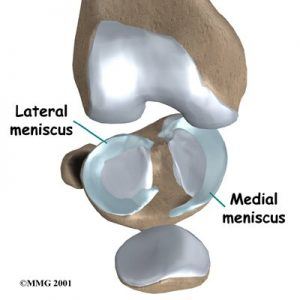Meniscal Tear

Meniscal Tear
A meniscal tear is a tear in the meniscus, a shock-absorbing structure in the knee. There are two menisci (plural of meniscus) in each knee, one on the inside (medial), and one on the outside (lateral).
Torn Meniscus

Symptoms
Torn meniscus may or may not cause symptoms. The ones that do not cause symptoms are usually small tears located in the back of the knee.
Symptoms may include:
- “Popping” sound at the time of the injury
- Pain
- Tightness
- Swelling within the knee, often called “water on the knee”
- Locking up, catching, or giving way of the knee
- Tenderness in the joint
Surgery
If your symptoms persist with nonsurgical treatment, your doctor may suggest arthroscopic surgery.
Knee arthroscopy is one of the most commonly performed surgical procedures. In it, a miniature camera is inserted through a small incision (portal). This provides a clear view of the inside of the knee. Your orthopedic surgeon inserts miniature surgical instruments through other portals to trim or repair the tear.

Partial Meniscectomy

In this procedure, the damaged meniscus tissue is trimmed away.
Meniscus Repair
Some meniscus tears can be repaired by suturing (stitching) the torn pieces together. Whether a tear can be successfully treated with repair depends upon the type of tear, as well as the overall condition of the injured meniscus.

Being able to repair the meniscus or having to perform a meniscectomy (partial removal) depends upon the location and complexity. Since the meniscus serves to protect the knee and prevent arthritis, Dr. Tony always tries to perform a repair if possible.
Causes
Most injuries to the meniscus are caused by trauma, usually compression and twisting of the knee. Movements that can cause trauma to the knee include pivoting, cutting, and decelerating. Because aging tends to break down the inner tissues of the meniscus, minor trauma (such as squatting) can injure the meniscus in an older person.
Risk Factors
A risk factor is something that increases your chance of getting a disease or condition. Risk factors for a meniscal tear include:
- Participating in contact sports
- Improper techniques for jumping, landing, pivoting, and cutting
- PreviousACL injury
Rehabilitation
- You usually will be able to fully weight bear with crutch assistance
- Gradually advance activity upon swelling resolution, walking properly regarding motion/strength and passing functional testing.
Because the meniscus must heal back together, recovery time for a repair is much longer than from a meniscectomy. Typically about 3 months longer.


